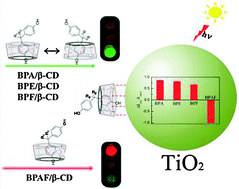β-Cyclodextrin's orientation onto TiO2 and its paradoxical role in guest's photodegradation†
Abstract
This work revealed that β-cyclodextrin was attached onto the surface of TiO2 predominately by its secondary ring side, which caused paradoxical functions of β-cyclodextrin in the photodegradation of the four


 Please wait while we load your content...
Please wait while we load your content...